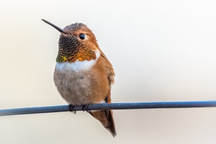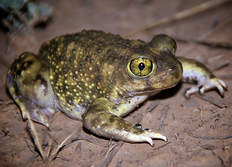 This morning I watched aghast as Mr. Rufous hit the window and fell to the ground. Rushing out to give him sugar water, I was so relieved to see him recover his wits and fly towards his cottonwood bower on his own. A very close call. Rufous, an iridescent coppery jewel arrived here on June 22 and his mate – just as beautiful in her less dramatic emerald and rust attire, came with him. My other resident hummingbirds (black chin, and broadtail) all seemed to be cooperating as they visited my two feeders. I wondered how Rufous and his wife would fit in so I have been keeping a sharp eye on hummingbird cooperation dynamics. Five weeks have gone by since their arrival, and this couple is staying to raise a family. It is true that this pugnacious little hummingbird can throw a wrench into cooperation but I have been pleasantly surprised to see this male and female sipping nectar with other birds sitting on neighboring perches. Could it be that the broadtail and black chin social dynamic has rubbed off on Mr. and Mrs. Rufous? I have no way of knowing but it does seem that they are more willing to compromise than most others I have known. Some days, of course, Mr. Rufous hovers above the feeders and making sudden aggressive dives scaring the others away with his high pitched squeaks and buzzing - but only for a few moments. Usually he lets the others return to share quite companionably. Mrs. Rufous seems very cooperative and she has taken to visiting the nastursiums, scarlet runner beans, fiery salvia, deep rose and scarlet penstemon and the pot that holds my bee, butterfly, and hummingbird friendly wildflower mixture that Iren gave me last spring. Apparently, the territories that the male and female rufous hummingbirds “defend” are somewhat different. Males hover over the primary food source(s) while the females extend their ranges further afield choosing less dense wildflower meadows. But this year, except for my little pot garden there are few wildflowers beyond the fence where I do not water, so choices, at least here, are limited. And Mrs. Rufous does not hog these flowers. Rufous hummingbirds are small with a short tail with mighty flight skills that allow them to travel 2000 miles from Mexico to as far north as Alaska for breeding in the western states. This migration can take place from as early as May to August in New Mexico, and some stop along the way to raise their families. They follow the wildflower season throughout the rocky mountain area. During their long migrations, they make a clockwise circuit of western North America each year moving up the Pacific Coast in late winter and spring, reaching Washington and British Columbia by May. As early as July they may start south again, traveling down the chain of the Rocky Mountains. The adult male has a slender bill, white breast, a rusty face, flanks and tail with a startlingly beautiful orange-red throat patch or gorget. Some males have some green on back and/or crown. The female has green, white, some iridescent orange and a dark tail with white tips. The female is slightly larger than the male and has longer wings. As many of us know they feed on nectar from flowers using a long extendable tongue or capture insects on the wing. These birds require frequent feeding while active during the day and go into a state of torpor at night to conserve energy. Because of their small size, they are vulnerable to insect-eating birds and animals. Most breeding habitats are open areas, mountainsides and forest edges in western North America and the Pacific Northwest. The female builds a nest in a tree or shrub and raises her brood of two chicks alone. The offspring are ready for flight in about three weeks. Surveys show continuing declines in rufous numbers during recent decades. Because they rely on finding the right conditions in so many different habitats at just the right seasons during the year, this hummingbird is especially vulnerable to the effects of climate change. These iridescent "flower birds," were considered gifts from the gods by Indigenous peoples. In Peru and other South American countries, naturalists have cataloged over three hundred species, and it is believed that not all have been discovered yet. The rain forests of South America were probably where hummingbirds first evolved (co-evolved) with flowers. I like to imagine that hummingbirds once sipped the life-giving nectar, leaving behind a pollinated forest before flying away, their burnished colors shimmering in a primal world of sunlight…
1 Comment
 The other day my friend Sabra regaled me with spadefoot toad stories that caught my hair on fire. Toads and frogs need water to thrive and the lack of rain has left me feeling paralyzed and obsessed at the same time over a thirst driven desert, and missing my liminal amphibious friends dearly. Listening to her talking about the toad holes in her garden - Sabra literally waters these round depressions every night until resident toads pop their heads out of the hole with their tongues sticking out! One year someone had made a sort of trench in the arroyo below Sabra’s house and it filled with water. One night they heard such a racket, that she thought a truck was stuck, and ran down the canyon and discovered that the toads were singing! These stories of hers made me realize that I feel exactly like a toad myself. I am starved for water from the sky. Every morning before I walk down to the river at dawn I turn on the sprinkler in front of the house to water the chamisa to keep one area green, but also to create a bathing area for the hummingbirds and other birds who take early morning baths under the spray. Everyone needs water…and I keep hoping that a toad or two might find this temporary early morning oasis at some point and move in. So far, no toads…my guess is that I would need a more permanent source of water, not to mention less heat (because most toads cannot survive temperatures above 86 degrees) to have some visit. Last year I heard one western toad and found one dead on the road, run over by a car. She was probably on her way to meet her croaking male suitor. No toad eggs appeared in Iren’s little pond, so my guess is that this female was the only other toad in the area. After Sabra told me about the spadefoots I immediately looked them up wondering if they also live down here by the river. Listening to the spadefoot’s call so I could recognize it, I was surprised at how different the calls of spadefoot sounded from the others – a weird grating sound. I also learned that the spadefoot is found in all of New Mexico’s 33 counties but I was not able to determine precisely where they prefer to live (Sabra lives on the Mesa). Some sources say they burrow near ponds and low areas but obviously they also like Mesas if they have a water source like Sabra does. When I learned that they were nocturnal, secretive, and totally dependent upon rain I realized I might have one in my area and not know it? I needed to learn that call. Distinguished by eyes with vertical pupils (other toads have horizontal pupils) that sit close to the top of their heads and small, hard, wedge-shaped structures on hind legs used for digging into moist soil, spadefoot toads vary in color (between gray, brown or dusky green). They are approximately 1.5 to 3.5 inches in length and when threatened they emit an odor said to smell like roasted peanuts. These toads can survive temperatures above 98 degrees, unlike most other toads. The amazing thing about spadefoots is that they spend most of the year underground in cocoons formed from layers of shed skin. This shedding of skins helps keep the toad from 'drying out' or dehydrating, and they stay alive in a state of ‘suspended animation’ called estivation. Some burrow three feet down in the ground. When summer rains fill low areas with water they emerge to feed for the year on insects (termites, ants, beetles and spiders but not worms as Sabra feared) and to breed. The males do the calling. Breeding takes place in temporary pools. Around a thousand eggs are laid in large masses and often hatch in as little as 48 hours. The tadpoles are forced to metamorphose in 7 – 13 days, the fastest developing of all toads. If the tadpoles hatch, little toadlets will eat frantically (they are omnivorous too) and burrow into the ground to wait for the next downpour. With this drought I can’t imagine water remaining above ground long enough for tadpoles to survive, even if we do have rainfall. The earth is so parched. It does not surprise me that most of the seven species of spadefoots are under threat of extinction, especially with global warming. Most sources say they are not ‘true toads’ because they do not have warty skin and they have teeth! Talk about living on the edge – wow – the fact that these amphibians have survived at all is a source of mind-bending amazement to me. |
Submit your ideas for local feature articles
Profiles Gardening Recipes Observations Birding Essays Hiking AuthorsYou! Archives
October 2025
Categories
All
|
 RSS Feed
RSS Feed